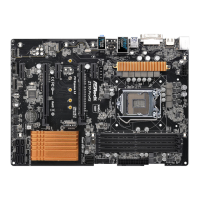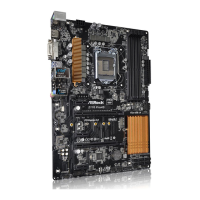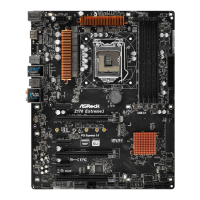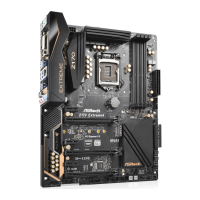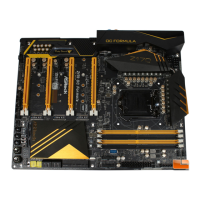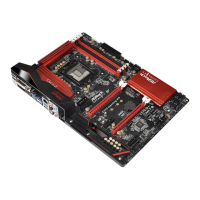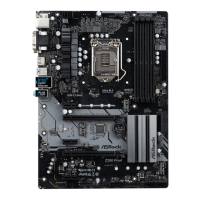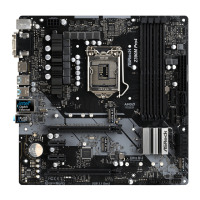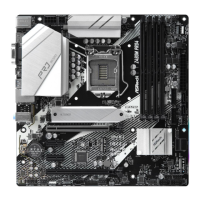Do you have a question about the ASROCK Z170 Pro4 and is the answer not in the manual?
Lists all items included with the motherboard.
Details the technical specifications of the motherboard components.
Illustrates the physical layout of motherboard components and connectors.
Describes the rear panel connectors and their functions.
Important safety and handling guidelines before installation.
Step-by-step guide for installing the CPU onto the motherboard.
Instructions for mounting the CPU cooler assembly.
Guide to installing RAM modules for dual channel configuration.
Details the types and configurations of PCIe slots on the motherboard.
Explains the function and usage of motherboard jumpers, especially Clear CMOS.
Describes the purpose and connection of various motherboard headers.
Instructions for setting up multi-GPU configurations using AMD CrossFireX.
Step-by-step guide to installing dual graphics cards for CrossFireX.
How to install drivers and configure AMD CrossFireX software.
Guide for installing an M.2 SSD module onto the motherboard.
How to install drivers and utilities from the support CD.
Introduction to ASRock's A-Tuning software for system management.
Steps to install the A-Tuning utility.
Overview of the A-Tuning interface and its sections.
ASRock's online store for purchasing and downloading software applications.
Describes the user interface of the Live Update & APP Shop.
Guide to finding, installing, and managing applications from the APP Shop.
How to update BIOS and drivers using the APP Shop.
Configuration options for the ASRock Live Update & APP Shop.
Overview of the UEFI Setup Utility and how to enter it.
Lists the main menu options available in the UEFI utility.
Explains the keyboard shortcuts and controls for navigating UEFI.
Describes the system overview displayed on the UEFI Main screen.
Details the options for overclocking system components within UEFI.
Allows configuration of CPU, Chipset, Storage, Super IO, ACPI, USB, and Trusted Computing.
Configures CPU-related settings such as core count and threading.
Settings related to the motherboard's chipset and its features.
Options for configuring SATA controllers, modes, and RAID.
Settings for Super I/O devices like serial ports and PS/2.
Power management settings related to ACPI states and wake-up events.
Settings for USB ports, including legacy support and emulation.
Options for enabling BIOS support for security devices like TPM.
Access to various system utility tools like System Browser and RAID installer.
Monitors system hardware status, including temperatures, fan speeds, and voltages.
Manages system passwords and secure boot settings.
Configures boot settings, device priority, and boot behavior.
Options for saving or discarding changes and exiting the UEFI utility.
Lists all items included with the motherboard.
Details the technical specifications of the motherboard components.
Illustrates the physical layout of motherboard components and connectors.
Describes the rear panel connectors and their functions.
Important safety and handling guidelines before installation.
Step-by-step guide for installing the CPU onto the motherboard.
Instructions for mounting the CPU cooler assembly.
Guide to installing RAM modules for dual channel configuration.
Details the types and configurations of PCIe slots on the motherboard.
Explains the function and usage of motherboard jumpers, especially Clear CMOS.
Describes the purpose and connection of various motherboard headers.
Instructions for setting up multi-GPU configurations using AMD CrossFireX.
Step-by-step guide to installing dual graphics cards for CrossFireX.
How to install drivers and configure AMD CrossFireX software.
Guide for installing an M.2 SSD module onto the motherboard.
How to install drivers and utilities from the support CD.
Introduction to ASRock's A-Tuning software for system management.
Steps to install the A-Tuning utility.
Overview of the A-Tuning interface and its sections.
ASRock's online store for purchasing and downloading software applications.
Describes the user interface of the Live Update & APP Shop.
Guide to finding, installing, and managing applications from the APP Shop.
How to update BIOS and drivers using the APP Shop.
Configuration options for the ASRock Live Update & APP Shop.
Overview of the UEFI Setup Utility and how to enter it.
Lists the main menu options available in the UEFI utility.
Explains the keyboard shortcuts and controls for navigating UEFI.
Describes the system overview displayed on the UEFI Main screen.
Details the options for overclocking system components within UEFI.
Allows configuration of CPU, Chipset, Storage, Super IO, ACPI, USB, and Trusted Computing.
Configures CPU-related settings such as core count and threading.
Settings related to the motherboard's chipset and its features.
Options for configuring SATA controllers, modes, and RAID.
Settings for Super I/O devices like serial ports and PS/2.
Power management settings related to ACPI states and wake-up events.
Settings for USB ports, including legacy support and emulation.
Options for enabling BIOS support for security devices like TPM.
Access to various system utility tools like System Browser and RAID installer.
Monitors system hardware status, including temperatures, fan speeds, and voltages.
Manages system passwords and secure boot settings.
Configures boot settings, device priority, and boot behavior.
Options for saving or discarding changes and exiting the UEFI utility.
| Non-ECC | Yes |
|---|---|
| Memory channels | Dual-channel |
| Memory slots type | DIMM |
| Number of memory slots | 4 |
| Supported memory types | DDR4-SDRAM |
| Maximum internal memory | 64 GB |
| Supported memory clock speeds | 2133, 2933, 2400, 3200, 3600, 2800 MHz |
| Processor socket | LGA 1151 (Socket H4) |
| Processor manufacturer | Intel |
| Compatible processor series | Intel Celeron, Intel Pentium |
| Maximum number of SMP processors | 1 |
| Certification | FCC, CE, WHQL, ErP/EuP |
| Component for | PC |
| Motherboard chipset | Intel® Z170 |
| Audio output channels | 7.1 channels |
| Motherboard form factor | ATX |
| Windows operating systems supported | Windows 7 Home Basic, Windows 7 Enterprise, Windows 7 Home Basic x64, Windows 10 Home, Windows 7 Home Premium, Windows 8.1, Windows 10 Pro, Windows 7 Home Premium x64, Windows 8.1 x64, Windows 10 Enterprise, Windows 7 Professional, Windows 8.1 Pro, Windows 10 Education, Windows 7 Professional x64, Windows 8.1 Pro x64, Windows 10 Home x64, Windows 7 Ultimate, Windows 8.1 Enterprise, Windows 10 Pro x64, Windows 7 Ultimate x64, Windows 8.1 Enterprise x64, Windows 10 Enterprise x64, Windows 10 Education x64, Windows 7 Starter, Windows 7 Starter x64, Windows 7 Enterprise x64 |
| BIOS type | UEFI AMI |
| ACPI version | 5.0 |
| BIOS memory size | 16 Mbit |
| DirectX version | 12.0 |
| Maximum resolution | 4096 x 2160 pixels |
| Maximum graphics card memory | 1792 MB |
| Parallel processing technology support | 4-Way CrossFireX, 2-Way CrossFireX |
| LAN controller | Intel® I219-V |
| Ethernet interface type | Fast Ethernet, Gigabit Ethernet |
| PCI Express x1 (Gen 3.x) slots | 3 |
| PCI Express x16 (Gen 3.x) slots | 2 |
| Number of SATA II connectors | 0 |
| Number of SATA III connectors | 6 |
| Supported storage drive interfaces | SATA III |
| USB 2.0 ports quantity | USB 2.0 ports have a data transmission speed of 480 Mbps, and are backwards compatible with USB 1.1 ports. You can connect all kinds of peripheral devices to them. |
| Cables included | SATA |
